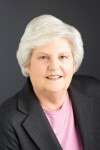AARP Hearing Center
Broken Nest Eggs: The Retirement Savings Crisis in America
By Nancy A. LeaMond, February 13, 2024 03:55 PM

Last week, I had the opportunity to gather with businesses and non-profit leaders, academics, media members and other key stakeholders for a candid conversation about the retirement savings gap and how to ensure American workers have access to a secure retirement.
I’m particularly appreciative of the opportunity to gather with folks who are operating on the front lines to tackle a problem that millions of Americans are confronted with every year…the stark reality that they are NOT financially prepared for retirement. In fact, nearly 1 in 5 adults 50+ say they have nothing saved for retirement. And, of those that do have money set aside for retirement, nearly a quarter have less than $50,000 saved. This, in part, translates to nearly a quarter of adults 50+ saying they never expect to retire.
The conversation got me thinking even more about some of the factors that contribute to this complex problem. Here are a few:
1. Americans are living longer than ever before.
Someone at sixty can expect to live another 20-plus years thanks to advancements in medicine, public health and living standards. This is undeniably a wonderful development, but one that also puts extra onus on folks to stretch their savings for decades past typical retirement age. As a result, more than half (57%) of all non-retirees age 50-plus expect to work in retirement for financial reasons. Many older workers are turning to gig or independent work, which comes with more freedom and flexibility than a traditional full-time position. The most cited reason for deciding to work independently is to “make extra money.” For many older adults, the new word for retirement is WORK.
2. Lack of access to retirement savings accounts.
We know that workers are 15 times more likely to save if they have a means to do so at work, and 20 times more likely if that savings is automatic. Yet, nearly half of private sector employees do not have access to retirement saving plans at work. Disparities in access to savings plans become even greater when you consider other factors such as business size and educational attainment of employees. For example, nearly 8 in 10 workers in firms with fewer than 10 employees lack access to a savings plan. And, more than three in four workers with less than a high school degree don’t have an employer-provided retirement plan, a significantly higher percentage than those with a bachelor’s degree or higher (32 percent).
3. Many older adults' only source of income in retirement is Social Security.
42% of Americans age 65+, more than 22 million people, count on Social Security for at least half of their income, including more than 10 million for whom it makes up 90% or more. For older women, the numbers are even higher. 46% of all 65+ women rely on Social Security for at least half of their income, including 48% of African-American and 42% of Hispanic/Latina women.
4. Sudden financial events, like experiencing a scam, can really set older adult’s long term financial stability back.
Adults of all ages fall victim to fraud, but when older adults experience a financial crime, they often have more to lose due to years of hard work and savings. For example, in 2022, those under 19 lost on average $300, while those 70-79 lost an average of $1,000 and those 80+ an average of $1,674. Older adults have less time to recoup these funds, putting a dent in their savings.
5. Rising prices threaten retirement security.
Despite some recent positive economic indicators, people’s pocketbooks continue to feel the weight of inflation. This impacts their ability to afford everyday necessities such as groceries, medical care, housing, and prescriptions. Older adults, many of whom are on a fixed income, are particularly sensitive to increased costs. In the end, spending more on the goods and services you need today leaves you with less saved for tomorrow.
6. The burdening costs of health care exhaust older adults’ retirement savings.
Reports find that health care continues to be one of the largest expenses in retirement, with one study determining that the average retired couple at age 65 may need approximately $315,000 saved to cover medical expenses. As a result, it is no surprise that close to half of adults aged 50+ say they are worried about having enough money to cover health care costs.
And in the face of these numerous and growing challenges, I’m proud of AARP’s efforts to boost Americans retirement security:
- To date, we’ve helped 19 states pass legislation to make it easier for folks to save money for retirement out of their regular paychecks who otherwise wouldn’t have access to a retirement plan at their workplace. A few examples of states with active programs include California, Colorado, Connecticut, Illinois, Maine, Maryland, Oregon, and Virginia. In total, these programs support 820,000 workers, 207,000 employers, and manages $1.2 billion in assets—a remarkable number as these programs are just beginning to operate. Our work in this area is not done, as already this year we are actively engaged in retirement savings advocacy efforts in nine states. Additionally, AARP is working with partners to build a foundation for future legislation in another six states and territories.
- We support federal legislation such as the bipartisan, bicameral, Retirement Savings for Americans Act. The bill would help more people across the country save for retirement by allowing full and part-time workers who lack access to an employer-sponsored retirement plan the ability to enroll in a portable retirement account. Another example would be the Automatic IRA Act of 2024, which would ensure most employers across the country are doing their part to help in this fight by providing their employees an opportunity to save at work.
- We fight to defend Social Security, the bedrock of retirement security in America, from cuts and policies that put the future of the program in jeopardy. And during this election year, we’ve been engaging candidates on their plans to strengthen Social Security for current and future generations.
- We work to educate older adults about the warning signs of scams through our Fraud Watch Network to help people avoid falling victim to a financial crime, as well as stand as a consumer advocate against the rising costs of utilities to ensure folks can keep more of their hard-earned dollars in their pockets and save for retirement.
Addressing the retirement savings gap is an important piece to improving the health and financial well-being of people as they age. We at AARP look forward to continuing our work on a whole host of fronts to improve retirement security for our 38 million members and all Americans across the country.
































































